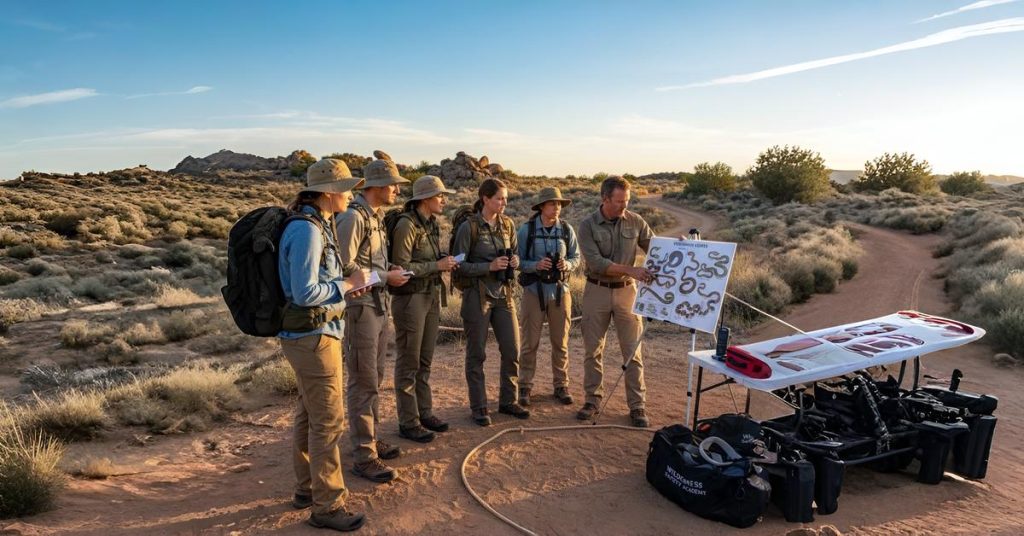
Every outdoor adventure begins with excitement and anticipation, but smart adventurers know that preparation separates memorable experiences from potential tragedies. With over 7,000 venomous snake bites occurring annually in the United States—resulting in 5-6 deaths and hundreds of serious injuries requiring extensive medical treatment—understanding snake safety isn’t just helpful knowledge, it’s potentially life-saving information.
The difference between a close call and a medical emergency often comes down to knowledge, preparation, and quick thinking. Whether you’re planning your first hiking trip through snake country, teaching your children about outdoor safety, or working professionally in environments where snake encounters are inevitable, this comprehensive safety guide provides the knowledge and tools you need to stay protected.
Snake safety goes far beyond just avoiding bites. It encompasses understanding snake behavior, recognizing dangerous species, knowing how to prevent encounters, responding appropriately when encounters occur, and handling emergency situations with confidence and effectiveness. This guide covers every aspect of snake safety, from basic prevention techniques to advanced emergency response protocols.
Our approach combines scientific knowledge with practical field experience, drawing from wildlife biology, emergency medicine, and thousands of hours of real-world experience in snake-prone environments. Whether you’re a weekend warrior or a seasoned outdoor professional, this guide provides actionable information that could save your life or the life of someone you care about.
Understanding the Snake Threat Landscape

Venomous Snake Species by Region
Understanding which venomous snakes inhabit your area is the foundation of effective snake safety. The United States is home to approximately 20 venomous snake species, each with distinct characteristics, behaviors, and geographic distributions.
| Region | Primary Venomous Species | Peak Activity Season | Preferred Habitat | Bite Risk Level |
|---|---|---|---|---|
| Southeast | Copperhead, Cottonmouth, Timber Rattlesnake, Coral Snake | March – October | Dense forests, wetlands, rocky areas | HIGH |
| Southwest | Western Diamondback, Coral Snake, Copperhead | April – September | Desert, scrubland, rocky terrain | HIGH |
| Texas | Western Diamondback, Coral Snake, Copperhead, Cottonmouth | March – November | Varied terrain, high diversity | VERY HIGH |
| Florida | Eastern Diamondback, Cottonmouth, Coral Snake, Pigmy Rattlesnake | Year-round activity | Wetlands, pine forests, suburban areas | HIGH |
| Great Plains | Prairie Rattlesnake, Timber Rattlesnake, Copperhead | April – September | Grasslands, rocky outcrops | MODERATE |
| Mountain West | Prairie Rattlesnake, Great Basin Rattlesnake | May – August | Rocky areas, high elevation forests | MODERATE |
| Pacific Coast | Western Rattlesnake, Northern Pacific Rattlesnake | April – October | Chaparral, oak woodlands | MODERATE |
Snake Behavior and Activity Patterns
Understanding when and why snakes are active helps predict and avoid dangerous encounters. Snake activity is influenced by temperature, season, weather conditions, and food availability.
Daily Activity Patterns:
Dawn (5:00-8:00 AM): High activity as snakes warm up from cool night temperatures
Mid-Morning (8:00-11:00 AM): Peak activity period for hunting and movement
Midday (11:00 AM-3:00 PM): Reduced activity during hot weather; snakes seek shade
Late Afternoon (3:00-6:00 PM): Second peak activity period as temperatures cool
Evening (6:00-9:00 PM): Active hunting period, especially during hot weather
Night: Reduced but present activity, particularly in very hot climates
Seasonal Patterns:
Spring (March-May): Increased activity as snakes emerge from winter dormancy
Summer (June-August): Peak bite season due to maximum snake activity and human outdoor time
Fall (September-November): High activity as snakes prepare for winter
Winter (December-February): Minimal activity, though warm days can trigger emergence
Comprehensive Prevention Strategies
Hiking and Trail Safety Protocols
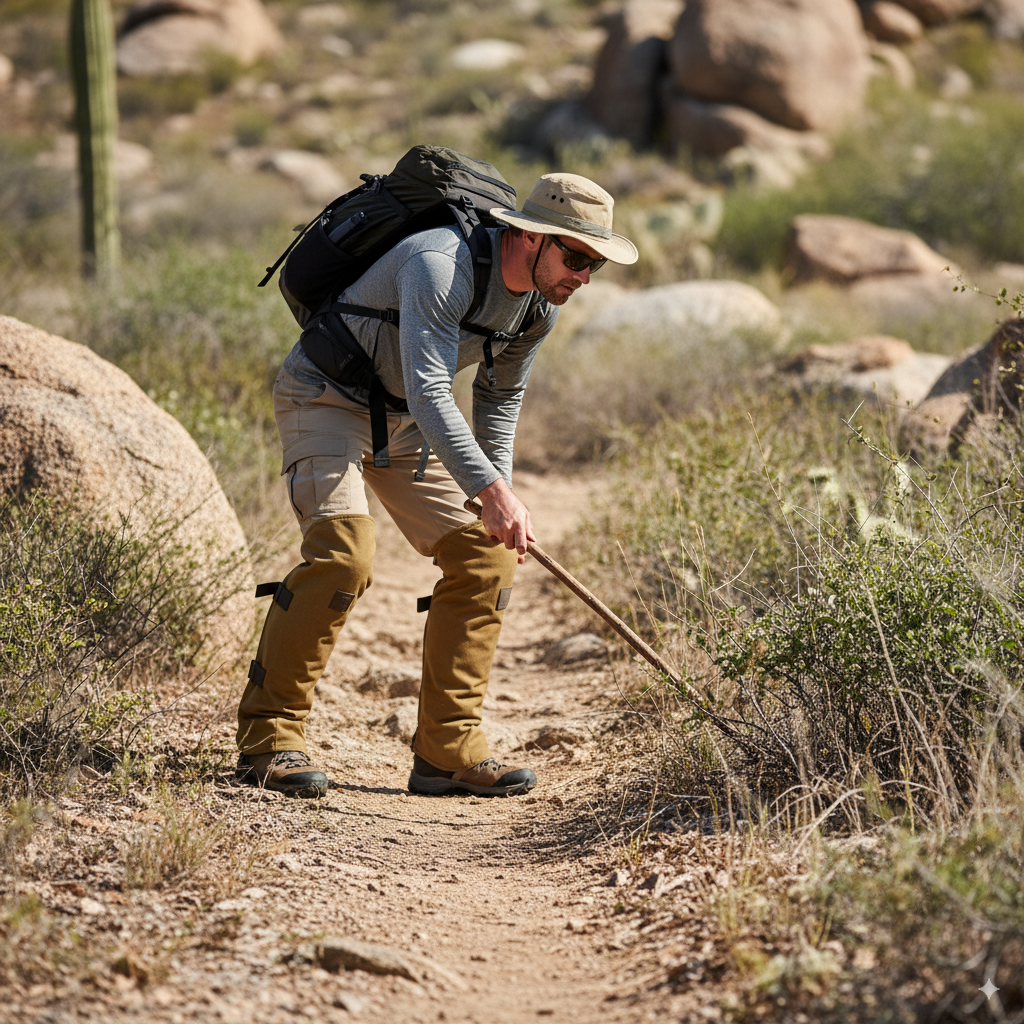
Hiking represents one of the most common scenarios for snake encounters, making prevention knowledge crucial for trail safety. Effective hiking safety combines awareness, preparation, and proper techniques for navigating snake country.
Pre-Hike Preparation Checklist: □ Research trail conditions and recent snake activity reports
□ Check weather conditions (warm weather increases snake activity)
□ Wear appropriate protective footwear and clothing
□ Pack snake bite first aid supplies
□ Inform others of your hiking plans and expected return
□ Carry communication devices for emergency situations
On-Trail Safety Techniques: Stay Alert: Maintain constant awareness of your surroundings, especially ground level
Make Noise: Talk or use hiking poles to alert snakes of your presence
Stick to Trails: Avoid bushwhacking through dense vegetation where visibility is limited
Use Light: Carry and use flashlights during dawn, dusk, or night hiking
Watch Step Placement: Look before placing feet or hands on rocks, logs, or vegetation
Avoid Overhangs: Don’t reach into areas you cannot see completely
For complete hiking safety protocols, see our detailed guide How to Prevent Snake Bites While Hiking.
Camping Safety and Campsite Management
Camping in snake country requires specific precautions to create safe sleeping and cooking areas while minimizing attraction factors that draw snakes to campsites.
Campsite Selection Criteria:
Choose open areas away from rock piles, fallen logs, and dense vegetation
Avoid camping near water sources where snakes come to drink
Select elevated areas with good visibility in all directions
Ensure adequate distance from known snake habitat features
Consider wind direction to avoid areas where snakes might seek shelter
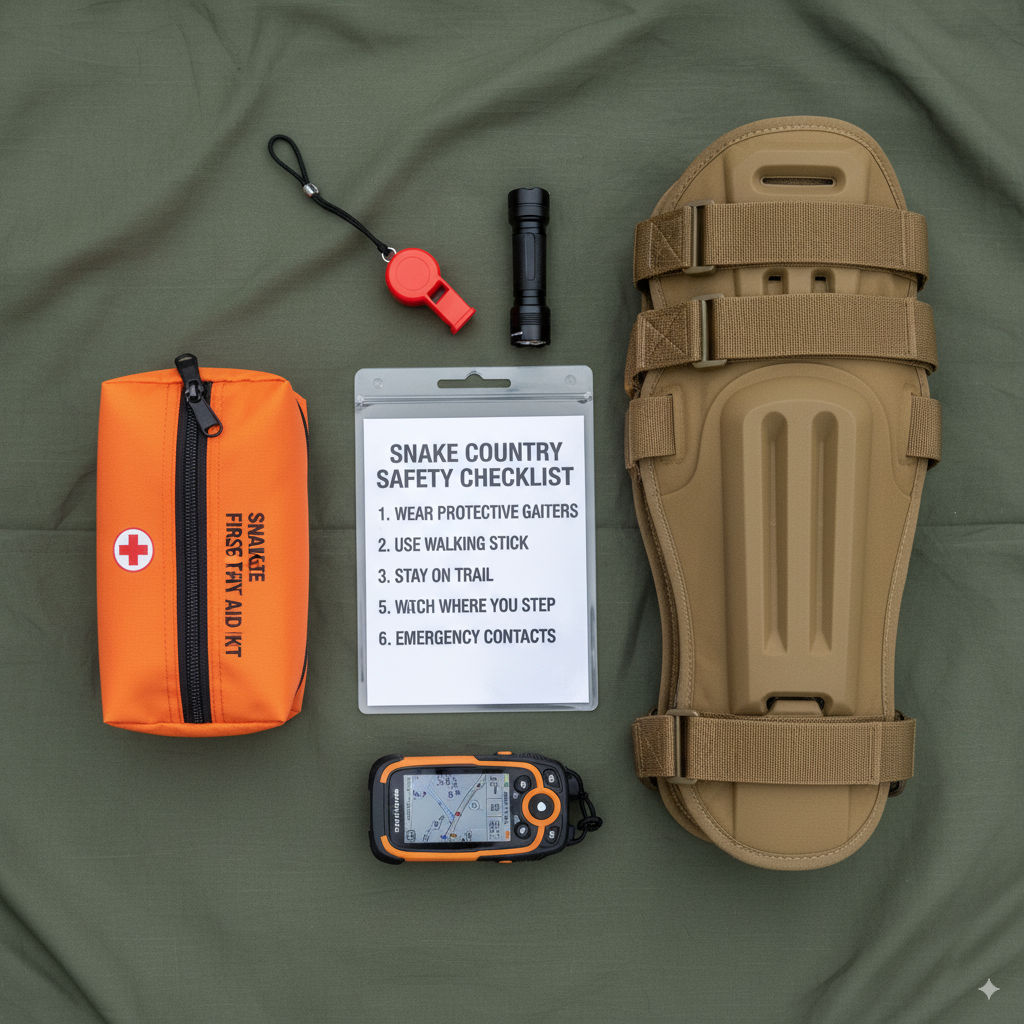
Campsite Setup and Management:
Clear the Area: Remove debris, rocks, and vegetation from camping area
Secure Food: Store all food in sealed containers to avoid attracting rodents
Maintain Cleanliness: Keep campsite clean to reduce pest attraction
Create Barriers: Use tent footprints and ground cloths to create defined sleeping areas
Lighting: Maintain adequate lighting around camp during evening activities
For comprehensive camping safety, see How to Prevent Snake Bites While Camping.
Occupational Safety for High-Risk Workers
Many professions involve elevated snake encounter risks, requiring specialized safety protocols and training for worker protection.
High-Risk Occupations:
Wildlife Biologists: Direct contact with snake habitats during research
Park Rangers: Patrol and maintenance duties in snake-prone areas
Utility Workers: Accessing equipment in overgrown or undisturbed areas
Construction Workers: Site development often displaces snakes
Agricultural Workers: Farming operations in rural areas with snake populations
Landscapers: Working around residential areas where snakes may shelter
Workplace Safety Protocols:
□ Mandatory protective equipment policies
□ Regular safety training and snake identification education
□ Emergency response procedures and first aid training
□ Communication systems for reporting snake encounters
□ Seasonal awareness programs during peak activity periods
Emergency Response and First Aid
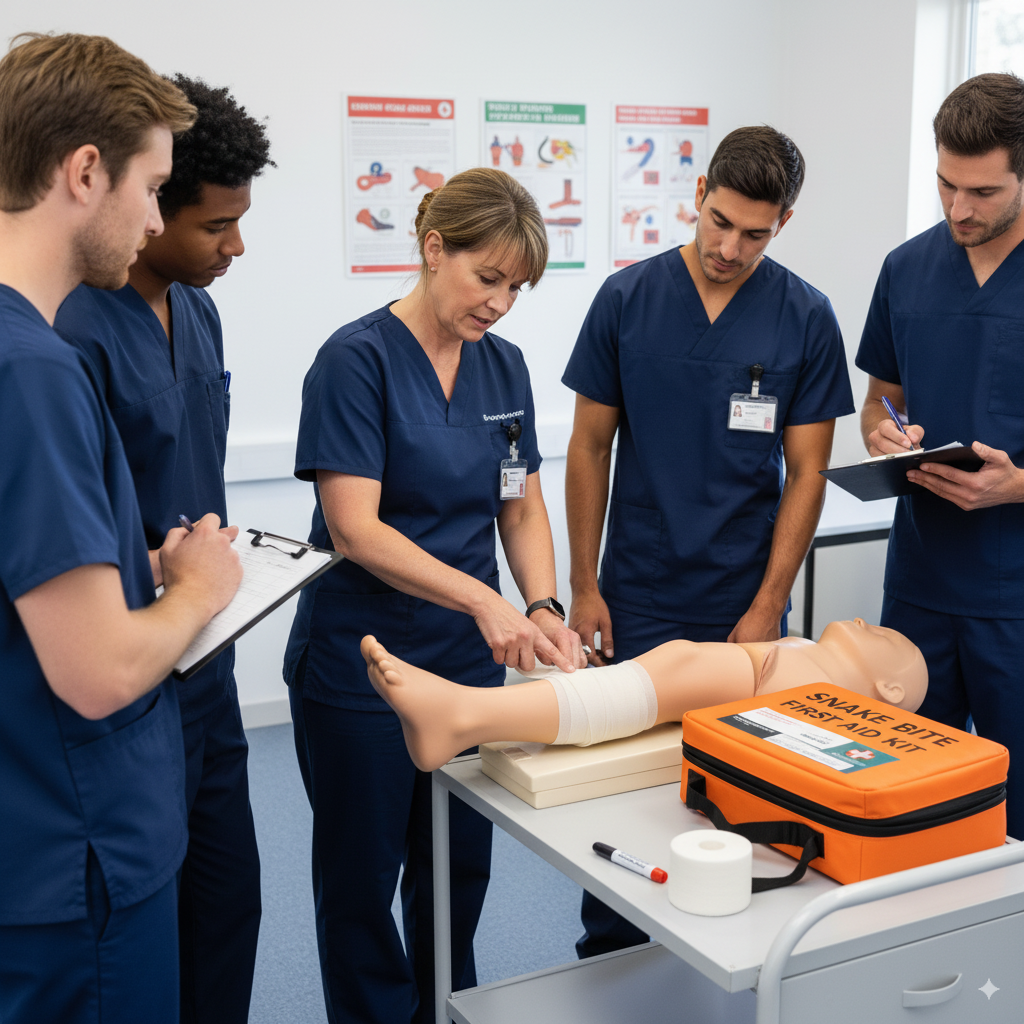
Snake Bite First Aid Protocol
Immediate response to snake bites can significantly impact medical outcomes. Proper first aid focuses on slowing venom spread while preparing for professional medical treatment.
| DO Immediately | DON’T Ever Do | Timeline |
|---|---|---|
| Call 911 immediately | Cut the bite wound | 0-2 minutes |
| Remove jewelry/tight clothing | Suck out venom | 0-5 minutes |
| Mark swelling progression | Apply ice or heat | Ongoing |
| Keep victim calm and still | Use tourniquets | Ongoing |
| Position bite below heart level | Give food, water, or alcohol | Ongoing |
| Take photos of snake if safe | Waste time identifying snake | If safe |
Detailed First Aid Steps:
Step 1: Immediate Response (0-2 minutes)
- Call emergency services (911) immediately
- Move victim away from snake if still present
- Have victim lie down and remain calm
- Remove rings, watches, or tight clothing near bite site
Step 2: Assessment and Documentation (2-5 minutes)
- Note exact time of bite occurrence
- Assess bite location and initial symptoms
- Take photos of bite site for medical reference
- Mark initial swelling boundaries with pen
Step 3: Ongoing Care (Until medical help arrives)
- Monitor and mark swelling progression every 15 minutes
- Keep bite site below heart level when possible
- Reassure victim and monitor for shock symptoms
- Prepare information for medical responders
Emergency Communication and Evacuation
Effective emergency response depends on clear communication and rapid evacuation when necessary. Preparation and planning significantly improve emergency outcomes.
Communication Essentials:
- Location Information: GPS coordinates, trail names, mile markers
- Victim Information: Age, weight, medical conditions, medications
- Incident Details: Time of bite, snake description, current symptoms
- Access Information: Best routes for emergency responders
- Resources Available: First aid supplies, personnel present, transportation
Evacuation Considerations:
- Ground Transport: Fastest option when roads are accessible
- Helicopter Evacuation: Required for remote areas without road access
- Walking Evacuation: Last resort when other options unavailable
- Victim Carrying: Proper techniques to minimize further injury
Species Identification and Risk Assessment
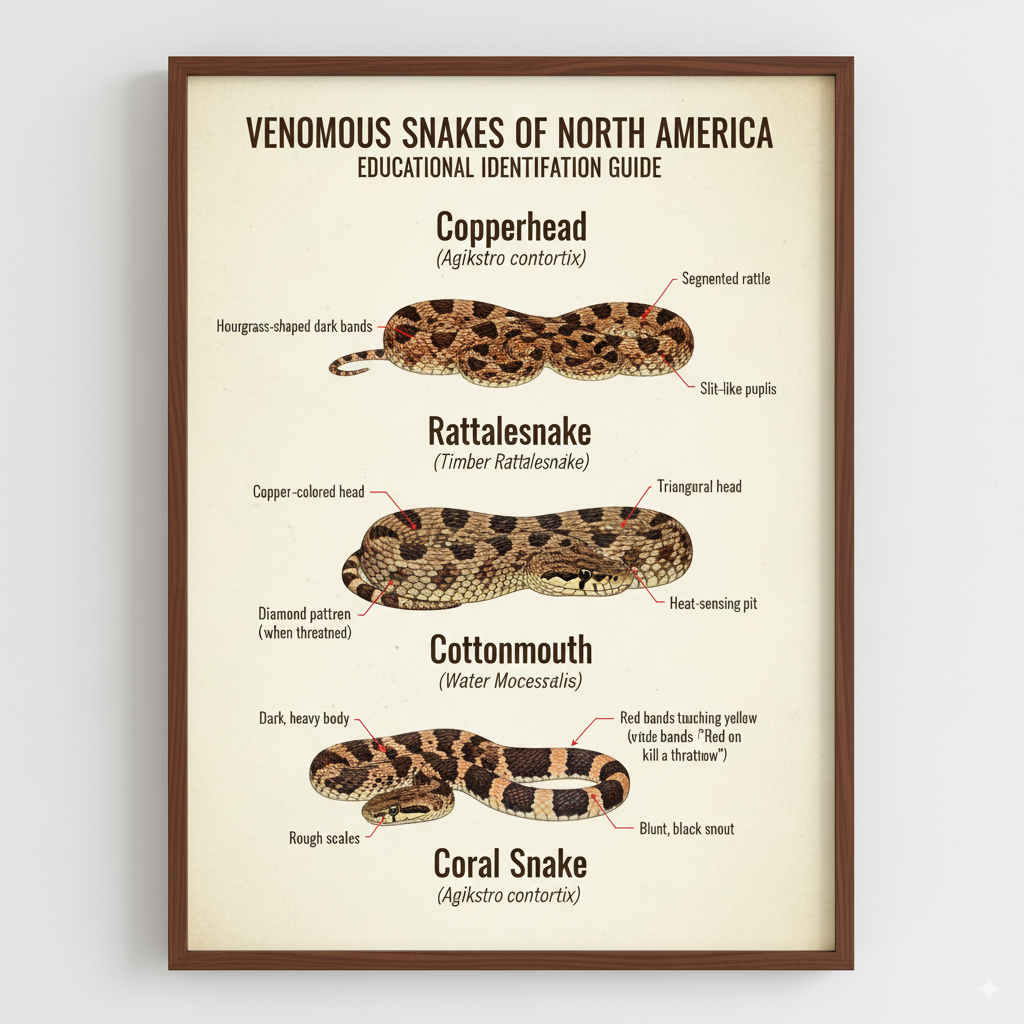
Venomous vs Non-Venomous Identification
Quick and accurate snake identification helps determine appropriate response levels and medical priorities. However, remember that ANY snake bite requires immediate medical attention.
Key Identification Features:
Venomous Snake Characteristics:
- Head Shape: Triangular, distinct from neck (with exceptions)
- Pupil Shape: Vertical, cat-like pupils (with exceptions)
- Body Pattern: Often (but not always) distinctive patterns
- Tail: Rattles on rattlesnakes, thick body tapering quickly
- Heat Pits: Visible pits between eyes and nostrils on pit vipers
Non-Venomous Characteristics:
No Heat Pits: Absence of facial heat-sensing pits
Head Shape: More rounded, gradual taper from body
Pupil Shape: Round pupils
Body Pattern: Variable, often less distinctive
Tail: Gradual taper, no rattle
⚠️ Warning: Never rely solely on these features for safety decisions. Some venomous snakes don’t fit these patterns, and proper identification requires extensive training.
Regional Species Profiles
Understanding specific species in your area helps with risk assessment and appropriate precautions.
Southeastern United States:
- Copperhead (Agkistrodon contortrix): Most common venomous bite, relatively mild venom
- Cottonmouth (Agkistrodon piscivorus): Semi-aquatic, aggressive when threatened
- Timber Rattlesnake (Crotalus horridus): Large, potent venom, generally docile
- Eastern Coral Snake (Micrurus fulvius): Small, potent neurotoxic venom, rarely bites
Southwestern United States:
- Western Diamondback (Crotalus atrox): Large, aggressive, responsible for most deaths
- Arizona Coral Snake (Micrurus euryxanthus): Small, rarely encountered, potent venom
- Rock Rattlesnake (Crotalus lepidus): Small, mild-mannered, less dangerous
Advanced Safety Techniques
Environmental Assessment Skills
Developing the ability to read environments for snake risk helps prevent encounters before they occur. This skill comes from understanding snake habitat preferences and behavior patterns.
High-Risk Environment Indicators:
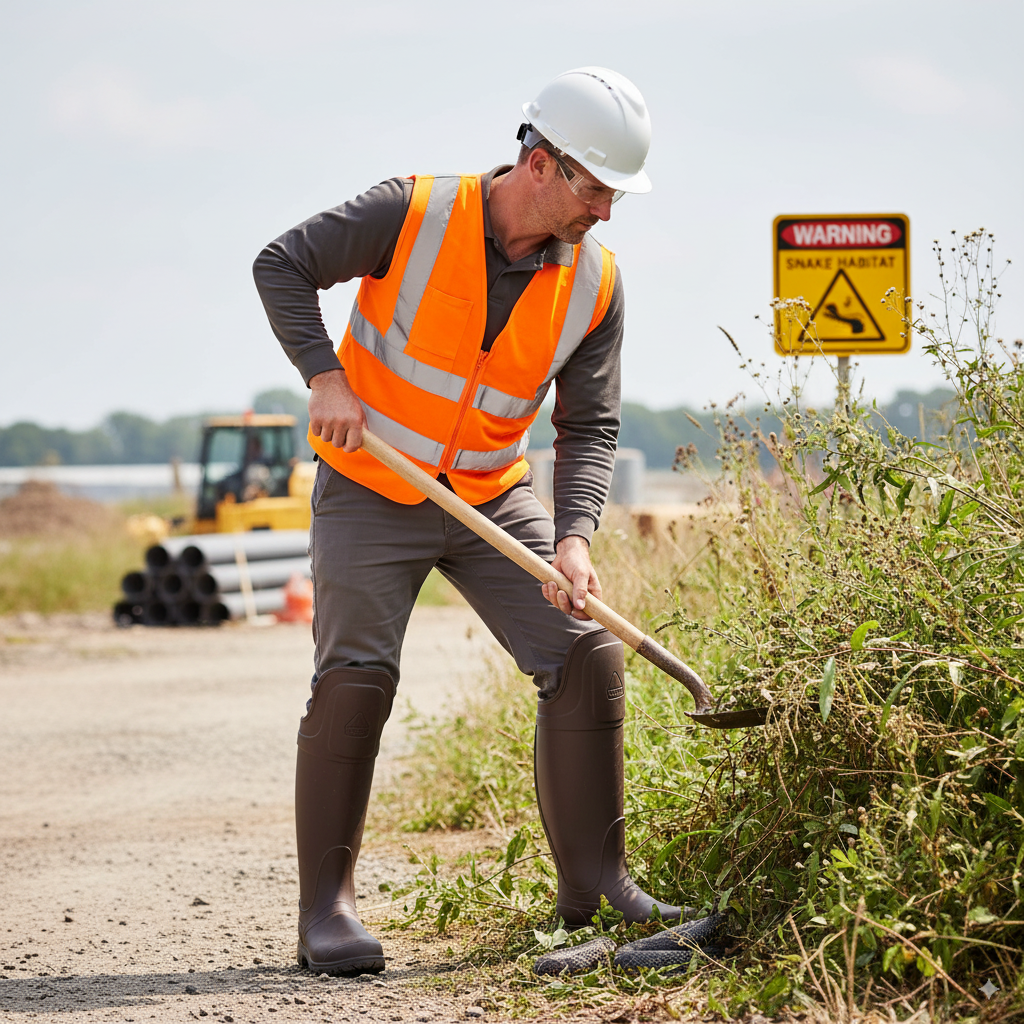
Recent Disturbance: Construction, logging, or flooding displaces snakes
Temperature: 70-90°F optimal for snake activity
Cover Objects: Rocks, logs, brush piles where snakes shelter
Water Sources: Streams, ponds, wetlands attract both snakes and prey
Edge Habitats: Where different habitat types meet
Risk Assessment Matrix:
| Factor | Low Risk | Moderate Risk | High Risk | Extreme Risk |
|---|---|---|---|---|
| Temperature | Below 60°F or Above 95°F | 60-70°F or 90-95°F | 70-85°F | 85-90°F |
| Season | Winter | Early Spring/Late Fall | Mid Spring/Early Fall | Summer |
| Time of Day | Midday (Hot Weather) | Morning/Evening | Dawn/Dusk | Night (Hot Areas) |
| Habitat | Open Areas | Light Cover | Dense Vegetation | Rock Piles/Water |
| Weather | Cold/Windy | Cool/Overcast | Warm/Humid | Hot/Still |
Group Safety Management
When leading or participating in group activities, additional safety considerations ensure everyone’s protection while maintaining group cohesion and safety.
Group Leadership Responsibilities:
- Safety Briefing: Educate all participants about snake risks and protocols
- Equipment Check: Ensure everyone has appropriate footwear and clothing
- Formation Management: Maintain safe group spacing and movement patterns
- Communication Systems: Establish signals for snake sightings and emergencies
- Emergency Planning: Designate roles and responsibilities for emergency response
Group Safety Protocols:
Emergency Procedures: Pre-planned response for bite incidents
Single File Movement: Through high-risk areas with designated leader
Sweep Person: Experienced person at rear to monitor group safety
Regular Stops: Check group status and address any safety concerns
Clear Communication: Immediate alerts for snake sightings or encounters
Specialized Safety Applications
Family and Children’s Safety
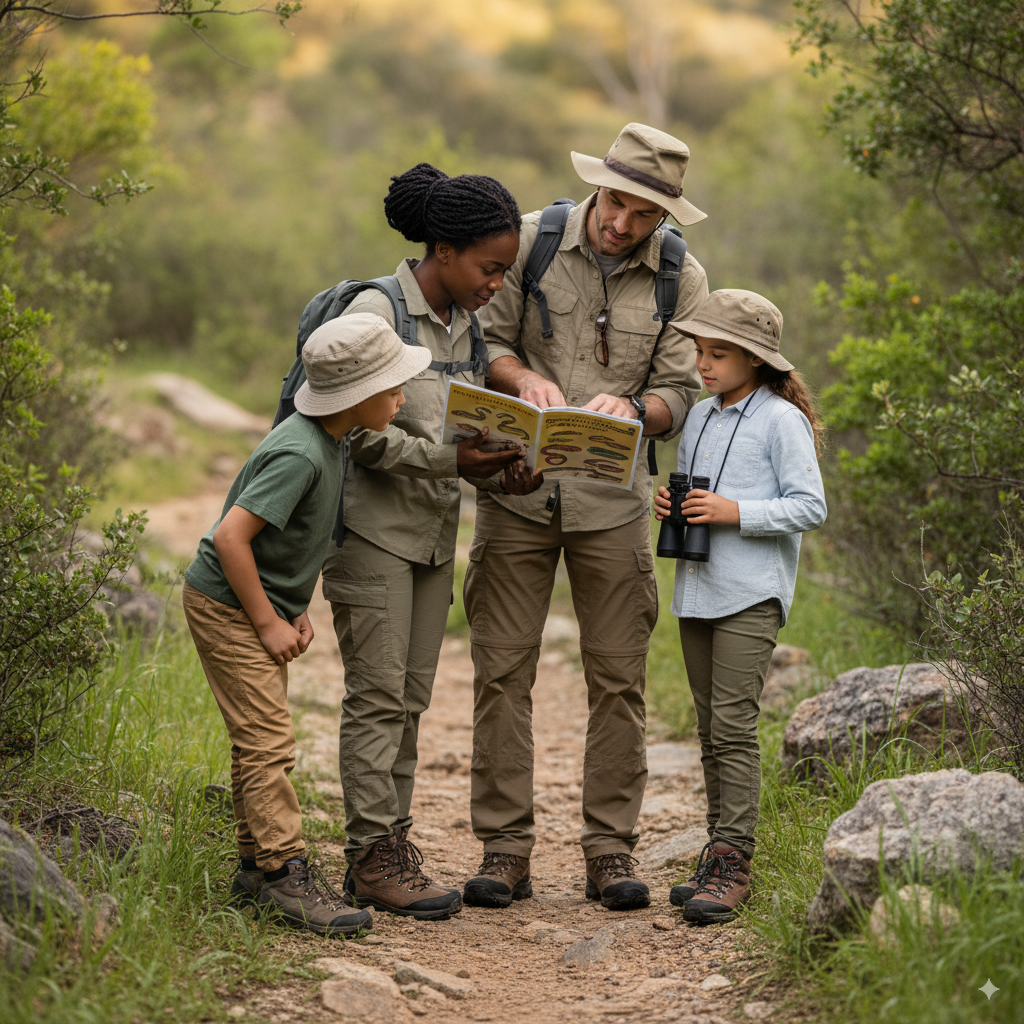
Teaching children about snake safety requires age-appropriate approaches that emphasize safety without creating excessive fear.
Age-Appropriate Safety Education:
Ages 3-6: Basic Safety Rules
- “Stop, don’t touch, tell an adult” for any snake encounter
- Stay on trails and paths when hiking
- Never reach into areas you cannot see
- Simple snake identification: “colorful = dangerous”
Ages 7-12: Expanded Knowledge
- Basic venomous vs non-venomous identification
- Understanding why snakes are important to ecosystems
- Proper hiking and outdoor behavior
- What to do if they see a snake (back away slowly, tell adults)
Ages 13+: Advanced Safety Skills
- Leadership responsibilities for younger children
- Detailed species identification for local area
- First aid basics and emergency procedures
- Environmental risk assessment skills
Professional Training Requirements
Certain professions require formal snake safety training and certification to ensure worker safety and regulatory compliance.
Training Components:
- Species Identification: Local venomous species and look-alikes
- Habitat Assessment: Recognizing high-risk environments
- Prevention Techniques: Proper equipment use and work practices
- Emergency Response: First aid and evacuation procedures
- Equipment Maintenance: Proper care of protective gear
Certification Requirements:
- Incident reporting and documentation procedures
- Initial training completion and testing
- Annual refresher training sessions
- Emergency response drill participation
- Equipment inspection and maintenance protocols
Equipment and Technology
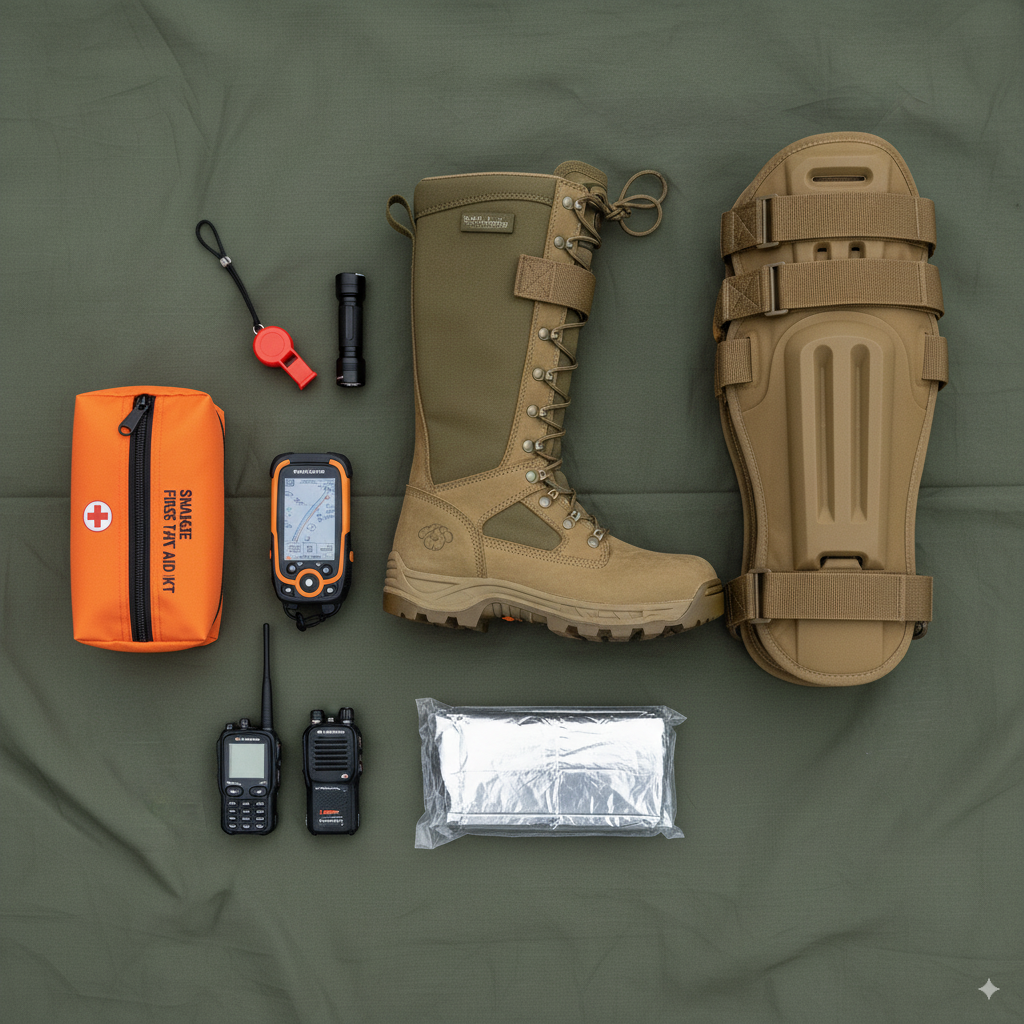
Essential Safety Equipment
Proper equipment significantly improves safety and emergency response capabilities during snake encounters.
Personal Protection Equipment:
- Snake Boots or Gaiters: Primary protection against bites
- Long Pants: Additional leg protection and coverage
- Gloves: Hand protection when working in snake habitat
- Eye Protection: Safety glasses in dense vegetation
- Hat: Protection from overhead hazards and sun
Emergency Response Equipment:
- Transportation: Vehicle access or evacuation planning
- First Aid Kit: Comprehensive snake bite supplies
- Communication Devices: Cell phone, satellite communicator, or radio
- Emergency Signaling: Whistle, mirror, or signal flare
- Documentation: Camera for bite photos and incident recording
For complete equipment recommendations, see Complete Snake Protection Gear Guide.
Technology Applications
Modern technology provides new tools for snake safety, from identification apps to emergency communication devices.
Mobile Applications:
- Snake Identification Apps: iNaturalist, Seek, regional snake ID apps
- Emergency Apps: What3Words for precise location sharing
- Weather Apps: Real-time conditions affecting snake activity
- Trail Apps: Current trail conditions and hazard reports
Electronic Devices:
- Emergency Beacons: Personal locator beacons for extreme situations
- GPS Units: Precise location for emergency response
- Satellite Communicators: Emergency communication in remote areas
- Snake Detection Devices: Experimental vibration and heat sensors
Myth-Busting and Common Misconceptions
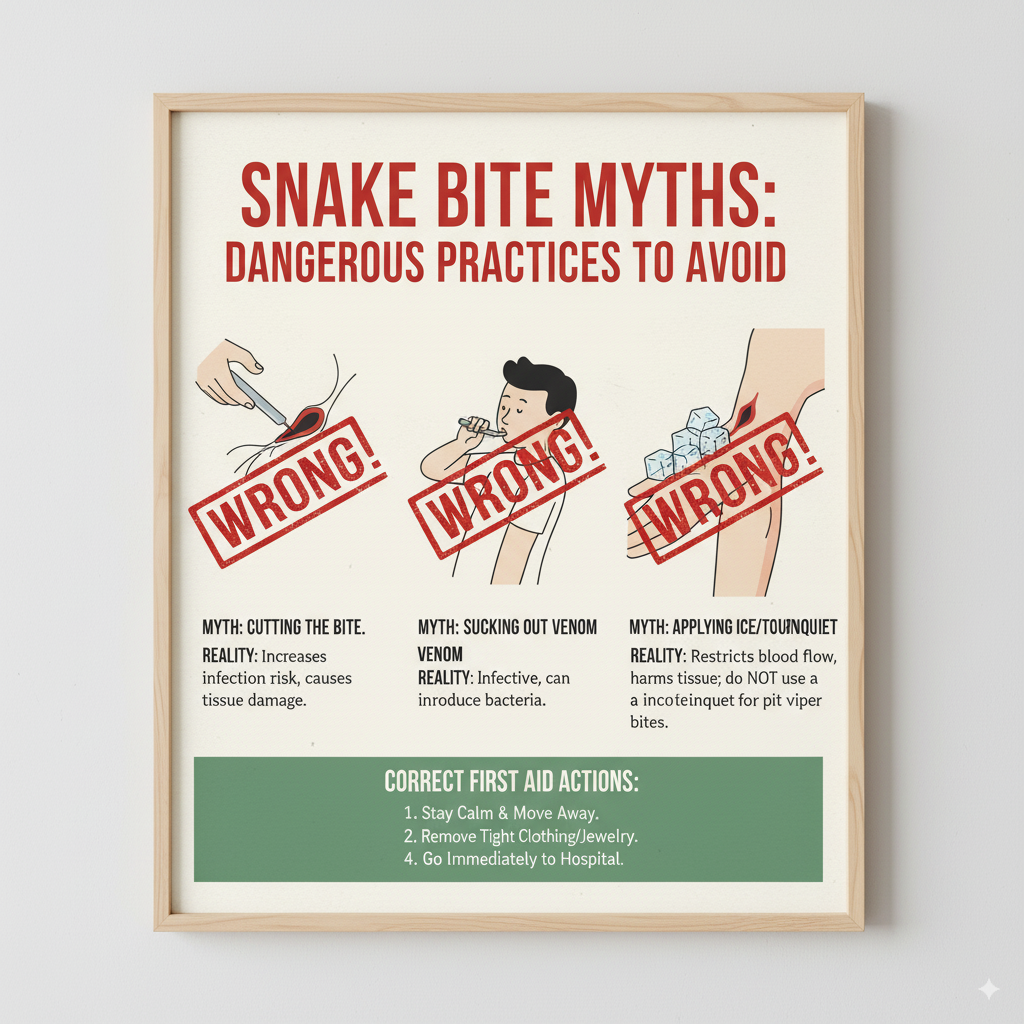
Dangerous Snake Safety Myths
Misinformation about snakes and snake bites can lead to dangerous decisions during emergencies. Understanding and correcting these myths is crucial for safety.
| Dangerous Myth | Reality | Why It’s Dangerous |
|---|---|---|
| “Suck out the venom” | Venom enters bloodstream immediately | Wastes critical time, causes additional damage |
| “Cut the bite open” | Increases bleeding and infection risk | Creates additional wounds, delays proper treatment |
| “Apply ice or heat” | Doesn’t help and may cause tissue damage | Can worsen tissue damage from venom |
| “Dead snakes can’t bite” | Reflexes remain active for hours | False confidence leads to careless handling |
| “Baby snakes are more dangerous” | Adults typically inject more venom | May lead to dismissing serious bites |
| “You can identify venomous by patterns” | Many exceptions exist | Misidentification can delay proper treatment |
Evidence-Based Safety Practices
Modern snake safety is based on scientific research and medical evidence rather than traditional folklore or assumptions.
Research-Supported Practices:
- Immediate Medical Attention: All venomous bites require professional treatment
- Antivenom Effectiveness: Modern antivenoms are highly effective when used properly
- Prevention Success: Proper protective equipment prevents most bites
- Education Impact: Training significantly reduces bite incidents
- Emergency Response: Quick, appropriate first aid improves outcomes
Seasonal Safety Considerations
Peak Risk Periods
Snake activity and bite risk vary significantly throughout the year, requiring adjusted safety protocols for different seasons.
Spring (March-May): Emergence Period
- Risk Level: HIGH – Snakes emerging from winter dormancy
- Key Hazards: Increased activity, mating behaviors, territorial aggression
- Special Precautions: Extra vigilance in areas with winter snake dens
Summer (June-August): Peak Activity
- Risk Level: VERY HIGH – Maximum snake and human activity overlap
- Key Hazards: Heat-seeking behavior, increased human outdoor activities
- Special Precautions: Dawn and dusk awareness, hot weather adjustments
Fall (September-November): Feeding Period
- Risk Level: HIGH – Intensive feeding before winter dormancy
- Key Hazards: Aggressive hunting behavior, movement to winter dens
- Special Precautions: Hunting season awareness, migration route caution
Winter (December-February): Dormancy Period
- Special Precautions: Don’t assume complete safety during warm winter days
- Risk Level: LOW – Minimal activity except on warm days
- Key Hazards: Unexpected emergence during warm spells
Weather-Related Risk Factors
Weather conditions significantly influence snake activity and encounter risk, requiring adjusted safety protocols.
- High-Risk Weather Conditions:
- Wind: Calm conditions allow better hunting success
- Temperature: 75-85°F optimal activity range
- Humidity: High humidity increases activity
- Barometric Pressure: Falling pressure before storms triggers movement
- Recent Rain: Increases activity 24-48 hours after rain events
Creating Your Personal Safety Plan
Risk Assessment for Your Activities
Developing a personalized safety plan requires honest assessment of your activities, skill level, and risk exposure.
Activity Risk Assessment Questions:
- What outdoor activities do you regularly participate in?
- Which geographic regions do you visit most frequently?
- What seasons are you most active outdoors?
- What is your current knowledge level about local snake species?
- How remote are the areas where you typically recreate or work?
Personal Risk Factors:
- Quality and appropriateness of your current protective equipment
- Experience level with outdoor activities and snake encounters
- Physical fitness and mobility limitations
- Medical conditions that might complicate emergency treatment
- Access to emergency medical care in your typical activity areas
Emergency Action Plan Development
Every outdoor enthusiast should have a written emergency action plan for snake bite incidents.
Emergency Action Plan Components:
□ Emergency Contacts: 911, poison control, local emergency services
□ Medical Information: Personal medical conditions, medications, allergies
□ Location Planning: GPS coordinates, access routes, nearest hospitals
□ Equipment Lists: Emergency supplies and their locations
□ Communication Plans: Who to notify and when during emergencies
□ Transportation: Vehicle access and backup evacuation plans
Plan Implementation Steps:
- Document Everything: Write down all plan components
- Share Plans: Ensure others know your plans and procedures
- Practice Drills: Regular practice of emergency procedures
- Update Regularly: Seasonal updates and equipment checks
- Review After Incidents: Learn from any encounters or close calls
Professional Resources and Training
Training Opportunities
Formal training significantly improves safety knowledge and emergency response capabilities.
Available Training Programs:
- Red Cross First Aid: Basic emergency response training
- Wilderness First Aid: Specialized remote area emergency training
- Professional Wildlife Training: Advanced programs for wildlife professionals
- Military/Law Enforcement: Specialized occupational safety training
- University Extension Programs: Regional snake safety workshops
Training Selection Criteria:
- Cost and accessibility of training programs
- Relevance to your specific activities and risk exposure
- Instructor credentials and program reputation
- Practical hands-on training components
- Certification requirements and renewal processes
Expert Resources
Access to expert knowledge and resources enhances your safety preparation and response capabilities.
Professional Resources:
Herpetologists: Snake behavior and identification experts
Emergency Medical Professionals: Bite treatment specialists
Park and Wildlife Services: Local area expertise and current conditions
Poison Control Centers: 24/7 expert advice for emergencies
University Extensions: Regional snake safety research and education
Conclusion: Building a Culture of Snake Safety
Snake safety is not about living in fear of outdoor activities—it’s about developing the knowledge, skills, and habits that allow you to enjoy outdoor pursuits with confidence and appropriate caution. Every snake encounter prevented through proper knowledge and preparation is a potential tragedy avoided.
The most effective safety approach combines multiple layers of protection: knowledge of snake behavior and identification, appropriate protective equipment, proper techniques for high-risk activities, and emergency preparedness for when encounters do occur. No single safety measure provides complete protection, but comprehensive preparation dramatically reduces risks.
Remember that snake safety is an ongoing learning process. Species distributions change, new research provides better understanding of snake behavior, and your own activities and risk exposure evolve over time. Stay current with safety information, maintain your equipment, and continue developing your knowledge and skills.
Share your knowledge with others. Every person you teach about snake safety becomes better protected and potentially helps protect others. Building a culture of safety awareness within your family, friend groups, and activity communities creates safer experiences for everyone.
Most importantly, maintain perspective about snake risks. While venomous snake bites are serious medical emergencies, they remain relatively rare events. Proper preparation allows you to enjoy outdoor activities with confidence while being appropriately prepared for the unexpected.
Critical Reminder: This guide provides educational information for prevention and emergency preparedness. In case of any suspected venomous snake bite, always seek immediate professional medical attention regardless of circumstances or apparent severity.
Written by Finlay Connolly